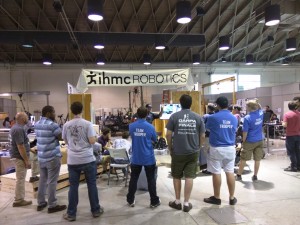OSS in DRC Final 2015DARPA Robotics Challenge でのオープンソース活用状況
During more than 30 workshop and seminars we’ve held since the Summer 2014, we are delighted to have talked to many engineers/managers (mostly from Japanese large companies) who’re interested in applying opensource software technologies to their development. Among other things, one of the most keen questions is how opensource software, particularly ROS, is going to be put into the “real/large systems”.
Seeking a hint, Isaac visited DARPA Robotics Challenge Final (DRC) in Pomona, CA., to see the evolution and the extent of opensource technologies in the very large scale robotics projects (he didn’t forget to cheer 3 teams from JSK lab our board member Kei Okada leads!).
There he was able to talk to managers from OSRF and asked how they view actual usage of ROS and Gazebo simulator in the competition, which the answer was later revealed on their blog stating that out of 23 teams, 18 used ROS and 14 used Gazebo. In addition, our own research brings out that 3 teams used OpenRTM via ROS and 1build their system on OpenRTM.
All robots from 24 teams must be very complexed system without exception; not just the transformer robots that a few most successful teams such as KAIST, CMU, JPL. Combined with the pressure to get the award and the amount of the resource spent, failures due to the system error should have not been an option for any team. Seeing the fact that the opensource technologies were employed for such a mission critical system’s control and operation is the most encouraging.
[Appendix] Interesting screenshot/movie is shared here…IHMC made their garage even theatrical to set a monitor at the entrance of their garage that played operation display. Operator is probably trying to match the location of the grasp target object while looking at the actual pose by seeing both camera and sensor output, and send the command. Despite the sparsely received pointcloud data (once in 30 seconds?) due to the hypothetical disaster network condition, the operator’s work looks very effective.
2014年夏から開始した ROS セミナー/ワークショップシリーズは,お陰様でこれまで30回以上開催し,多くの企業/研究者様と意見交換をさせて頂いております.その会話の中で必ずと行って良いほど話題に上がるのは,オープンソース技術,とりわけ ROS は今後実システムに使われるようになっていくのかということです.ロボット開発用ソフトウェアのデファクトスタンダードという言い方をされる (Wired 誌) こともある ROS ですが,実際は用途は研究に限られ,大規模プロジェクトや製品,産業用途としての取組は徐々に本格化しつつある段階というのが大方の見解ではないかと思います.
折しも今年の5・6月は世界的に大きな競技会が続いたので,ロボット業界の大イベントである DARPA Robotics Challenge Final (DRC) の会場を訪れることにし,オープンソースのロボット技術の潮流を体感することにしました (当協会理事・岡田准教授の出場チームの応援は無論ですが!).
#なお DRC については詳細は省きます.例えば日刊工業新聞記事などをご参考まで.
さて,参加チームは,競技が終了するまでは目一杯でしょうし,突然訪れて技術の根幹を教えてくれるわけもありません.そこはそれ,ROS の運営を行う米・オープンソースロボティクス財団 (OSRF) の幹部達と話したところ (当協会理事・斉藤が以前同財団でインターンした際の上司でもあります),既に多くのチームが ROS を利用している感触を得ているとのこと.後日同財団 WEB サイトに掲載されたレポートによると,23チーム18チームにおいて ROS が,14チームにおいて Gazebo シミュレータの利用が確認されたとのことでした.また,当協会独自の調べでは,3チームが ROS 経由で OpenRTM を利用しており,1チームは OpenRTM を中心にシステムを構成していました.
参加した24種類のロボットの形態は,最多を占めた二足歩行だけでなく,優勝した KAIST の変形型や多足など,バラエティに富んだものとなりましたが,どのロボットも例外なく複雑なシステムであったと思われます.また,億を超える優勝賞金,投入するリソースの量からしても,各チームともシステムエラーによる失敗はまず避けたかったはずです.そのようなミッションクリティカルなシステムの制御にオープンソースの技術がこれだけ多くのチームで使われたというのは,オープンソース支持者として喜ばしい限りです.
[オマケ] ロボットの貴重な操作画面を撮影出来たので共有します.上位入賞した米・IHMC のものです.カメラ画像とセンサー画像両方を見つつ,環境モデル中のオブジェクトと知覚情報とを合わせた後に,タスク指令を出していると思われます.災害下の通信が不安定な想定のため,pointcloud が数十秒間に一回しか更新されない厳しい状況でも,そつなく作業を進めているのが見て取れます.このような高信頼が求められるシステムにおいて,ハードウェアでなくソフトウェア・ベースの入力装置が多くのチームに用いられたのも興味深いことでした,
なお IHMC は Java ベースの独自開発のプラットフォーム用いており,ROS API もあるとのこと.NASA JSC が開発中の二足歩行ロボット Valkyrie (2016年には Space Robotics Challenge のプラットフォームとして使用される) も同じソフトを使うそうです.
サービス精神旺盛の IHMC チームのガラージ前はこのようにモニターが据付けられ,チーム内外の人が気軽に観戦できるようになっている.小さいが写真奥には,競技中のロボットを操作するメンバーと DARPA の監視役メンバーが作業している.

著者について